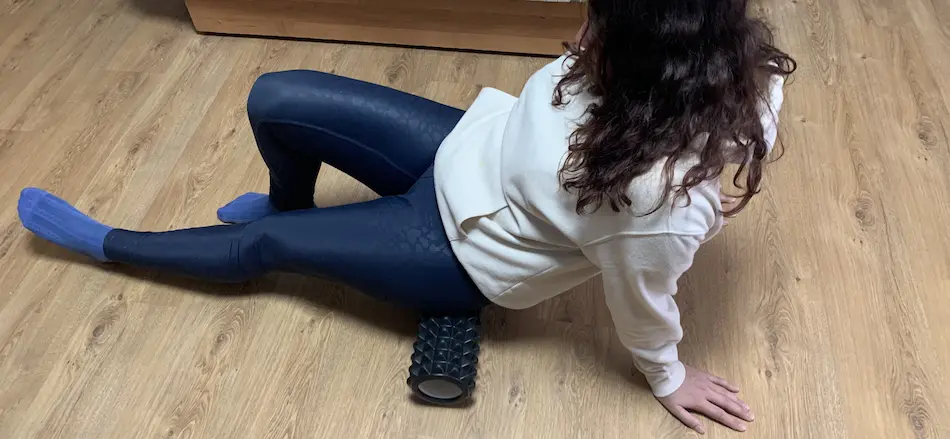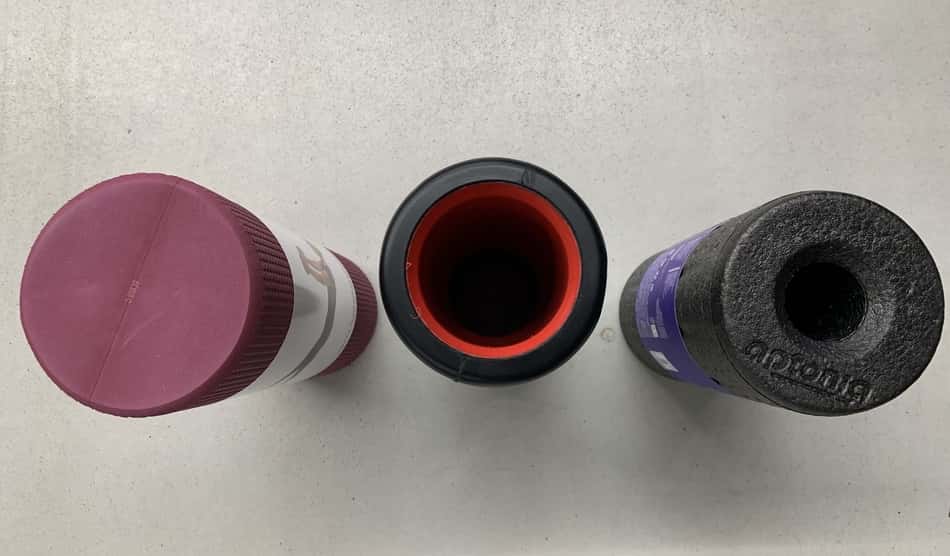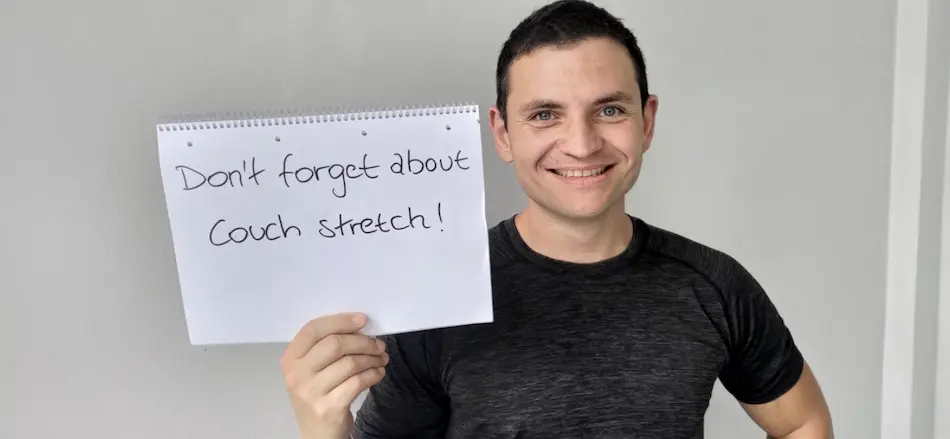We tried and tested all 22 peloton foam rolling classes. Here are the top 5 we recommend you should do after your next long and strenuous bike ride.

One of the best (and easiest) things you can do to reduce some of the muscle soreness after peloton rides is myofascial release using a foam roller.
- It’s quick – Each class takes 10 to 20 minutes so you can do it first thing in the morning or immediately after your peloton class (you don’t have to warm up before foam rolling).
- It’s easy – All you need to do is follow the instructor (Hannah Corbin, one of the senior’s peloton instructors is teaching most of the classes).
- It’s effective – Foam roll after peloton workouts can help you improve blood flow, decrease biomechanical stiffness, and restore muscle and joint range of motion. You may also feel less muscle tension in the legs, which is good for post-exercise recovery.
- It can feel painful at the start – Foam rolling muscles can feel pain in the beginning if you haven’t done it before (just like massage). But don’t feel discouraged. The more often you do it, the less pain you will feel.
You can find foam rolling classes in the peloton app in the “stretching” category under the “foam rolling” tab in the filter.
In addition to seeing the list below, I also wrote a list of tips for beginners at the end that includes things like how often to use peloton foam rolling classes or which foam roller should you choose.
So it’s worth checking it out.
1. Peloton Foam Rolling Calves
The first class you should try is the “foam rolling calves”.
If you like to do a lot of cycling, running, or peloton HIIT workouts, your calves can absorb a lot of that force in order to buffer the impact from the ground.
Needless to say, this impact can put a lot of pressure on your gastrocnemius soleus complex, which can make your calves more stiff and tight.
In the beginning, you may feel that your calves are sensitive to touch. However, the more often you foam roll, the easier it will get.
If you feel like your calves are very tight, I recommend you should do this after each peloton ride. Later on, feel free to reduce the frequency to 3-4 times per week.
Pros
The peloton foam rolling calves class it’s easy to understand and suitable for all levels of fitness. You don’t need prior experience in foam rolling to get the benefits and feel the results.
Cons
This class does include many foam rolling exercises, but it doesn’t have stretching. I think that doing a combination of stretching and foam rolling together would lead to better results.
Did you know? The calf muscles are called the second heart. That is because the calf muscle pump influences venous blood dynamics. This means the more you move, the more streaming of blood is generated in vertical, as well as horizontal directions.
2. Peloton Foam Rolling Hamstrings
If you’re a runner, you probably experienced once or twice muscle tension in the hamstring.
Fortunately, by doing the peloton foam rolling hamstrings class (which only takes you a 10-minute) you can relax the muscles and break up the scar tissue that causes muscle restriction.
If you wanna get the best results and really smoke out muscle restrictions, release the tension and reclaim the optimal range of motion, try to do this class before and after your next peloton ride.
I often do two foam rolling classes (before and after), especially for my longest and hardest peloton classes.
By doing two sessions (one before and one after) you not only can restore the full range of motion but also penetrate the trigger points that occur after cycling or long-distance running.
Pros
I like to foam roll my hamstring becasue it helps with my recovery.
My legs don’t feel so heavy after rides and I find it easier to walk up and down the stairs.
I also feel fewer muscle cramps at night.
Cons
I think this class should include more accessories like massage rollers or lacrosse balls.
I also find that I can get better access to the muscle when I sit on a chair or bench.
Here you can see the video from Kelly Starrett, Ph.D., an expert on mobility and author of Becoming a Supple Leopard, that shows how to target hamstrings with a lacrosse ball (at 2:38 in the video).
Note, it’s one of several where Dr. Starrett explains this:
3. Peloton Foam Rolling Quads
If you’re looking for a way to release muscle tension and reduce delayed onset muscle soreness (DOMS), I recommend checking out the foam rolling quads class.
In this 10-minute session, your main goal is to foam roll your thighs and IT band.
For me, foam rolling quads always feel uncomfortable because of the trigger points (also called fascial adhesions).
(Think of them as the gummy spots where fascia sticks to surrounding tissues.)
These spots can be sensitive to palpation. Therefore, it is normal that you may feel temporary pain due to compression from the foam roller.
Pros
I often choose this class after a hard workout, long-distance traveling, or whenever I’m being immobilized in a sitting position for a long time.
I also like to combine these foam rolling classes with a classic couch stretch (one of the most effective quad-stretching positions, in my opinion).
Here in the video (starts at 0:42), you can see Dr. Starrett showing how to do a couch stretch
Cons
One thing you may notice is that the IT band is brutally painful to foam roll.
IT band is a long connective fascia, the continuation of the tensor fascia lata, gluteus medius, and gluteal Maximus.
It’s attached to several parts of the body, so it has a significant effect on muscle mechanics and force transmission.
So in the beginning, don’t be surprised if you feel significant pain from this class. I recommend taking it easy, adding some breaks, or even reducing the foam rolling time to 30 seconds per muscle.
4. Peloton Foam Rolling Chest and Back
This class is great if you’re looking for ways to mobilize your upper body. More specifically, this class is good to reduce tension from your muscles around the scapula, chest, and shoulders.
I spend hours each day in front of the computer screen, so adding this class to my weekly workout plan was a game-changer.
You can do this wokrout daily, especially if you spend a significant amount of time doing high-volume of cycling, driving the car, or sitting at the desk.
Foam rolling chest and back is often neglected because it requires more skill to precisely target those muscles.
Pros
You can do this class not only to reduce muscle tension after strength training wokrouts but also randomly during the day.
For instance, I find that foam rolling upper body helps to combat some of the postural adaptations that I develop, thanks to my “not-so-perfect” lifestyle and sitting position.
Cons
I don’t think that using an 18-inch foam roller is the best way to target large muscle groups like the upper back, neck, and chest.
To get to those little corners, I recommend you use a double lacrosse ball or a massage roller. These tools have a much smaller diameter and can penetrate to these muscles more precisely.
See the video below from BuildLean (starts at 1:39) where they explain how to use smaller rollers to get to the upper back more effectively.
I think that using the 18-inch foam roller is sub-optimal because of a lot of curvatures and bonny surfaces.
The upper body, the scapula, and the clavicle stand in the way to get that deep access into the actual muscle tissue.
I like to use something like a peanut ball or lacrosse ball that allows for better access, without causing discomfort.
Did you know? The seated position leads to disorganization around the spine area and forces the body to compensate. As a result, you may experience a lot of neck pain, kinks in the neck, a rounded upper back, and a computer neck, also called a “tech neck”.
5. Peloton Foam Rolling Glutes
Now let’s talk about the foam rolling glutes. My advice is to use this class after your workout, as well as before the session to activate the muscle fibers.

If you want to get better output during your peloton FTP test or long-distance rides, this is a great mobility class.
All you need is 10 minutes. Hannah Corbin, the peloton instructor, combines foam rolling with stretches for the glutes and hips.
Also, please remember that sitting inhibits muscle activity (also called gluteal muscle inhibition).
This means that over time, the muscle gets weaker and doesn’t engage in the most efficient way (simply because it hasn’t been used for so long).
Pros
This class has many good exercises that cover all the corners and efficiently target gluteal muscles. I like to spend 5 minutes before any rides to foam roll and “wake up” my glutes.
For better results, you can add resistance band exercises (especially the glute loops). This can help you to increase the blood flow and fire up more fibers, compared to foam rolling alone.
Here you can see the video from Bret Contreras, Ph.D., CSCS, an expert on glute training on how to use bands to engage the glute more effectively (at 4:08 in the video).
Cons
I think that foam roller is not the only tool for this job. If you want to get better access to the glutes, I recommend using the medicine ball.
It’s bigger than a lacrosse ball so it can get to the muscle more precisely.
Here in the video check out the Stacey Wiggins explains the differences between the two (starts at 1:38).
Peloton foam rolling tips for beginners
Whenever you want to improve your range of motion, or you’re sick and tired of feeling sore after your workouts, here I have a list of some tips for beginners that can help you personalize your foam rolling experience.
In case you wonder, there are no official guidelines on using a foam roller in the most “optimal” way. So all the tips that I will share with you come from my own experience.
Is foam rolling supposed to hurt?
Yes, in the beginning, foam rolling is gonna hurt. If you never used the foam roller, you can expect that your muscles carry (usually) a lot of tension.
Also remember that some muscles and body parts (IT band, quads, upper back) will be more sensitive than others.
The good news you can get better with practice. As your muscles get loose, there will be fewer trigger points, less pain, and more muscle suppleness.
After several weeks, it will almost feel like a relaxing massage, rather than painful torture.
How often should you do peloton foam rolling classes?
You can do peloton foam rolling classes 3-5 times per week. Start slowly by doing 10-minute classes.
In the beginning, I was only able to foam roll for 30-60 seconds per muscle (especially my calves).
After few weeks, after I got rid of most of the trigger points, it felt much easier (I actually started to like it more later).
Today, I try to foam roll after each peloton ride (I don’t necessarily follow the class anymore).
When is the best time to foam roll?
There is no right or wrong answer to when you should be foam rolling (it depends on your schedule and muscle tension).
- In the morning – It’s fine to start foam rolling immediately after you wake up. You can always combine this class with other mobility or peloton stretching classes.
- Before your ride – As I’ve mentioned before, I really like to spend some time before my biggest rides to roll on the mat. This can help you to improve your range of motion and make your rides easier.
- After your workout – Ideally, you want to foam roll immediately after your exercise and every 24 hours thereafter (This would be the best option if you never did foam rolling before). 10 minutes is not a lot, but it can massively reduce muscle soreness.
How long should you foam roll?
One of the drawbacks of the peloton foam rolling classes is that the duration is set (kind of like a cookie-cutter).
According to Grace Couture, PT, from the Grand Valley State University in Michigan, the 2 minutes of the foam roller isn’t enough to induce improvements in flexibility.
“Your duration will vary and depend on your muscle tension and your frequency of the foam rolling,” says Dr. Courture.
Andrew M. Murray, Ph.D., a professor from The University of Edinburgh, says that anything less than 60 seconds does not affect muscle flexibility.
As a general rule, the foam rollers do work, as long as you spend between 60 to 90 seconds per muscle (even up to five minutes) or until a release is felt.
(When I say release I mean the feeling in the muscle is getting loose.)
So it should not be a “one-size-fits-all” approach.
That’s why I recommend trying and testing by yourself.
How to choose a foam roller for Peloton?

I think I’ve used hundreds of different foam rollers and the most common question I get around this topic is how do I choose the right foam roller?
Choosing the right foam roller will depend on the muscle areas you want to work on.
- Regular foamy rollers are great to work on large parts of the body.
- Massage sticks or massage balls are more effective to reach those small deep muscles.
The best foam roller for the peloton should be made from a high-density material that ensures solid compression and durability.
The foam rollers that are soft and look like a pool noodle initially may work, but in the long term, they don’t give enough pressure to make a significant change.
To actually feel the change, you need a certain amount of pressure. I always like to look at the density because you can tell immediately how much effect you get.
More density equals more pressure.
Here in the picture below you see three different foam rollers.

The one that I use is the one in the middle.
It has a solid plastic frame and a high-density rubber coat. The one on the left is a pilates foam roller, great for a class but not for myofascial release.
What can I use instead of a foam roller?
I used all sorts of things instead of a foam roller (even a bottle of wine).
You can use several tools:
- Kettlebell
- PVC pipe
- Medicine ball
- Lacrosse ball.
How to find Peloton foam rolling classes?
You can find the peloton foam rolling classes in the stretching category. Alternatively, you can type “foam rolling” in the search box in the top left corner of the main menu.
Keep in mind that Peloton doesn’t sell foam rollers in their online store, so you have to order them online.
You can get a solid foam roller from Amazon, Walmart, or your local sports shop. Alternatively, you can look for massage sticks or massage balls.
Conclusion
- Adding some of the best peloton foam rolling classes can be a part of your warm-up to enhance muscle activation.
- You can also use them after your main session to restore the range of motion.
- Also keep in mind that initially, you can feel discomfort.
- Frequent manipulation of the soft tissue results in temporary muscle stimulation, leading to delayed onset muscle soreness (DOMS), similar to post-massage soreness and malaise (PMSM).
- After a couple of weeks when the muscles relax and the body increases the pain tolerance, the discomfort goes away.
PS. Don’t forget about couch stretch!

